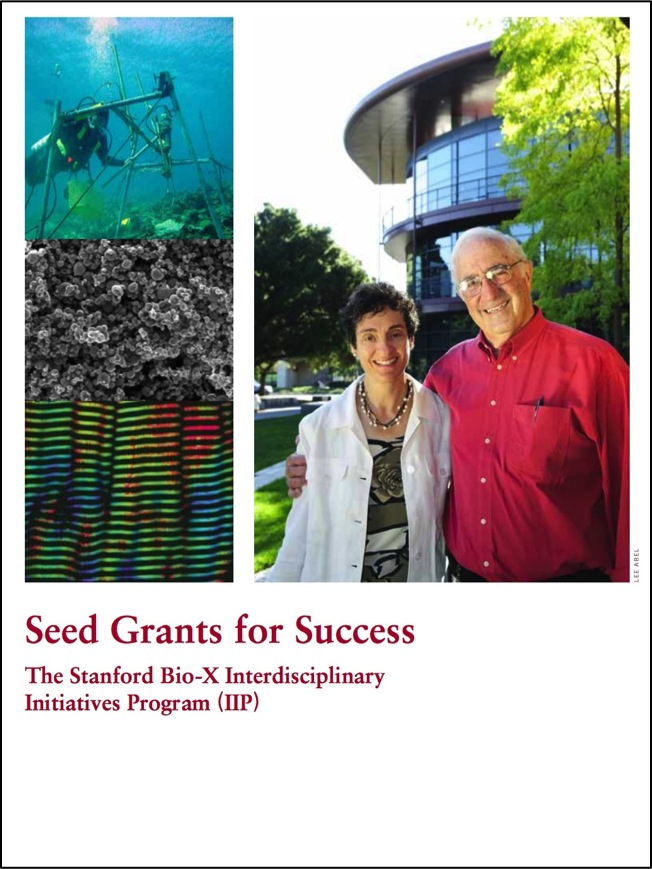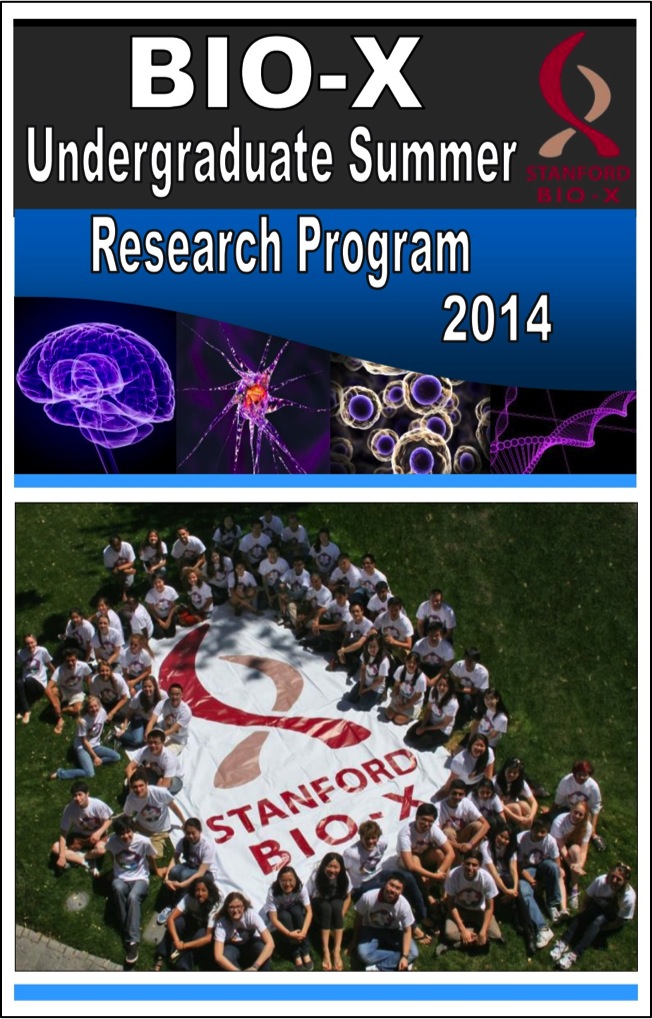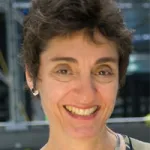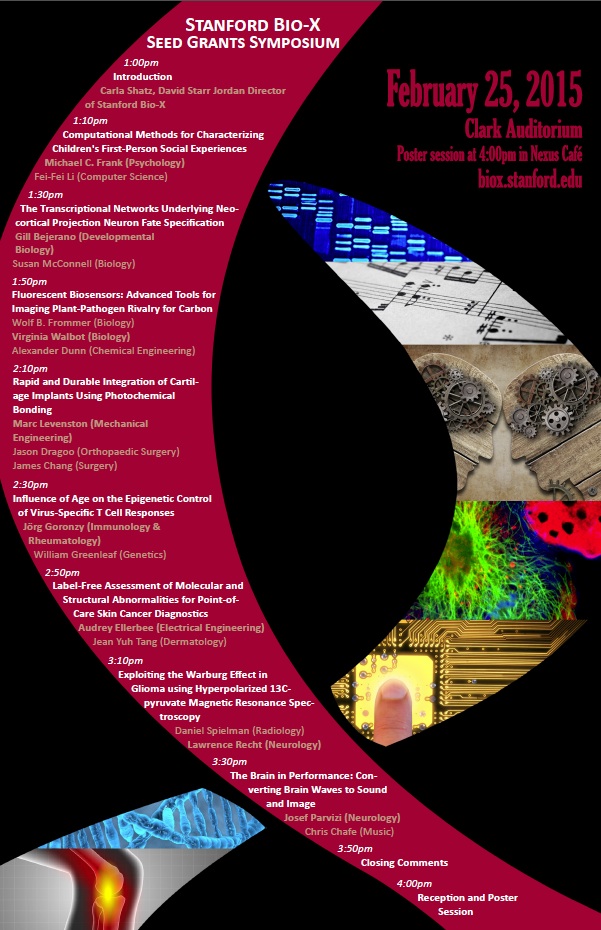
Welcome to the biweekly electronic newsletter from Stanford Bio-X for members of the Bio-X Corporate Forum. Please contact Dr. Hanwei Li, the Bio-X Corporate Forum Liaison if you would like to be added or removed from this distribution list, or if you have any questions about Stanford Bio-X or Stanford University.
Highlights
** On October 9, 2013, Bio-X celebrated the 10th Anniversary of the James H. Clark Center, the hub of Bio-X. Check out CLARK CENTER @ 10X as well as the Bio-X Timeline over the last 15 years!!
** Check out the article by Stanford President John Hennessy in the Nov/Dec 2013 issue of the Stanford Magazine on Bio-X and the Clark Center, "A Cauldron of Innovation".
Bio-X Core Programs
 SEED GRANTS FOR SUCCESS - Stanford Bio-X Interdisciplinary Initiatives Program (IIP) SEED GRANTS FOR SUCCESS - Stanford Bio-X Interdisciplinary Initiatives Program (IIP)The Bio-X Interdisciplinary Initiatives Program represents a key Stanford Initiative to address challenges in human health. Currently, the IIP awards approximately $4 million every other year in the form of two-year grants averaging about $200,000 each. From its inception in 2000 through the beginning of the seventh round in 2014, the program has provided critical early-stage funding to 164 different interdisciplinary projects, involving collaborations from over 750 faculty members, and creating over 700 teams from six different Stanford schools. From just the first 6 rounds, the IIP awards have resulted in a 10-fold-plus return on investment, as well as hundreds of publications, dozens of patents filed, and most importantly, the acceleration of scientific discovery and innovation. 2014 is the start of the 7th round of the Bio-X IIP Seed Grants Program, and 22 newly awarded projects were selected from 142 Letters of Intent (LOIs)! This has been the largest number of LOIs that Bio-X has received. Please go here to check out the newly awarded projects. Competition was intense, and the selection criteria included innovation, high-reward, and new interdisciplinary collaborations. (To view the 142 other IIP projects that have been funded from the previous 6 rounds, please click here.) |
 Bio-X FELLOWSHIPS Bio-X FELLOWSHIPSEvery year, graduate students and postdoctoral scholars of Bio-X affiliated faculty are highly encouraged to apply for the Bio-X Fellowships, which are awarded to research projects that are interdisciplinary and utilize the technologies of different fields to solve different biological questions. Students are encouraged to work collaboratively with professors of different departments, thus creating cross-disciplinary relationships among the different Stanford schools. Our fellows have conducted exciting research, resulting in publications in high-impact journals and have been offered excellent positions in industry and academia. To date, with the 19 new awardees of 2014, Stanford Bio-X has a total of 173 Fellows. The call for 2015's PhD Fellowship program has just begun! You can view the numerous Fellowship projects that have been awarded over the years as well as oral presentations from previous symposiums here. |
 Bio-X UNDERGRADUATE SUMMER RESEARCH PROGRAM Bio-X UNDERGRADUATE SUMMER RESEARCH PROGRAMThe Bio-X Undergraduate Summer Research Program supports undergraduate research training through an award designed to support interdisciplinary undergraduate summer research projects. The program is an invaluable opportunity for students to conduct hands-on research, learn how to carry out experiments in the laboratory, and develop the skills to read and analyze scientific literature. This program is eligible to Stanford students who want to work in the labs of Bio-X affiliated faculty. To date, with 65 new awardees from 154 applications submitted this year, 306 students have been awarded the opportunity to participate in the Bio-X Undergraduate Summer Research Program. The call for 2015's USRP has just begun! Participating undergraduates are also required to present poster presentations on the research that they've conducted during the program. Please click here for title lists of past posters that our undergraduates have presented. |
We are cultivating and are highly successful in building meaningful collaborations with numerous corporate colleagues. New collaborations through our core programs are highly encouraged. To learn about how to get involved, please contact Dr. Hanwei Li, or Dr. Heideh Fattaey.
Bio-X also holds symposiums every year that highlight our core programs. The latest one was on August 27, 2014, where over 300 people attended Bio-X's latest Interdisciplinary Initiatives Seed Grants Program Symposium. There were 8 different oral presentations from faculty members who were awarded Bio-X Seed Grants on the progress that they have made with the funding towards their projects. In addition, Bio-X had its largest poster session ever with 167 posters presented during the reception of the symposium! If you'd like to learn more about any of the projects that were presented during the entire symposium, please contact Dr. Hanwei Li with your questions.
News

 Unlocking the brain's plasticity
Unlocking the brain's plasticity
Bio-X Director Carla Shatz
Bio-X Undergraduate Summer Research Program Participant Richie Sapp (2011, 2013)
Richie Sapp knew when he came to Stanford as an undergraduate that he wanted to participate in brain research. His twin brother was born with hydrocephalus – swelling in the brain – and as a result he has learning impairments and is on the autism spectrum. Growing up with his brother and volunteering extensively with people with special needs got Sapp interested in how the brain works. "If we can understand the brain, there is a possibility we can help people maximize their potential," Sapp said. After emailing and meeting with several faculty members as a sophomore, Sapp joined the lab of Carla Shatz, the David Starr Jordan Director of Stanford Bio-X, who studies how connections between neurons are made and maintained in the brain. "I was very excited by the questions they were asking," said Sapp, who did an honors thesis based on his research, for which he won the 2013 Firestone Medal of Excellence in Research. "That's what got me going, sitting in the lab getting to talk to the other lab members about new experiments." Sapp graduated in 2013 and is now working on a master's degree in biology while continuing to work in the Shatz lab.

 Researchers discover insulin-decreasing hormone in flies, humans
Researchers discover insulin-decreasing hormone in flies, humans
Bio-X Affiliated Faculty Seung Kim
Bio-X Fellow Ron Alfa
An insulin-regulating hormone that, until now, only had been postulated to exist has been identified by researchers at the Stanford University School of Medicine. The hormone, called limostatin after the Greek goddess of starvation, Limos, tamps down circulating insulin levels during recovery from fasting or starvation. In this way, it ensures that precious nutrients remain in the blood long enough to rebuild starving tissues, rather than being rapidly squirreled away into less-accessible fat cells. The researchers first discovered limostatin in fruit flies but then quickly identified a protein with a similar function in humans. “Starvation or famine is an ancient, ever-present specter faced by all living organisms,” said Seung Kim, MD, PhD, professor of developmental biology. “The ways to deal with it metabolically are likely to be ancient and conserved. This research clearly connects the dots between flies and humans, and identifies a new potential way to regulate insulin output in humans.” In particular, members of a family with an inherited mutation in the human analog of limostatin exhibited many of the same physiological characteristics as flies genetically engineered to be unable to produce limostatin — namely, high levels of circulating insulin, low blood sugar levels and a tendency toward early onset obesity. A paper describing the research findings was published Feb. 3 in Cell Metabolism. Kim is the senior author, and graduate student Ronald Alfa is the lead author.
 Study ties immune cells to delayed onset of post-stroke dementia
Study ties immune cells to delayed onset of post-stroke dementia
Bio-X Affiliated Faculty Marion Buckwalter
A single stroke doubles a person’s risk of developing dementia over the following decade, even when that person’s mental ability is initially unaffected. Why this delayed deterioration occurs has been a mystery. Now, Stanford University School of Medicine investigators think they have discovered a major reason for it. In experiments using both mouse models of stroke and brain-tissue samples from humans, they linked the delayed onset of post-stroke dementia to the persistent presence in the brain of specialized immune cells that shouldn’t be there at all. The discovery could potentially translate into ways of identifying people at risk for dementia, allowing physicians time to try to stave off the disease. Drugs that can disable these immune cells are already available.
 Different mental disorders cause same brain-matter loss, study finds
Different mental disorders cause same brain-matter loss, study finds
Bio-X Affiliated Faculty Amit Etkin
In a study analyzing whole-brain images from nearly 16,000 people, researchers at the Stanford University School of Medicine identified a common pattern across a spectrum of psychiatric disorders that are widely perceived to be quite distinct. The meta-analysis of 193 peer-reviewed papers, published Feb. 4 in JAMA Psychiatry, reports a loss of gray matter in three brain structures that, although physically separate, participate in a network associated with high-level functions, including planning and decision-making. The findings call into question a longstanding tendency to distinguish psychiatric disorders chiefly by their symptoms rather than their underlying brain pathology. In any given year, nearly one in five Americans meets the criteria for a diagnosis of psychiatric illness. “The idea that these disorders share some common brain architecture and that some functions could be abnormal across so many of them is intriguing,” said Thomas Insel, MD, director of the National Institute of Mental Health, who wasn’t involved in the study but is familiar with its contents.
 Face blindness predicted by structural differences in the brain, Stanford neuroscientists discover
Face blindness predicted by structural differences in the brain, Stanford neuroscientists discover
Bio-X Affiliated Faculty Kalanit Grill-Spector
Recognizing the faces of family and friends seems vital to social interaction. However, some individuals lack this essential skill. Those with a condition called face blindness, or prosopagnosia, can see eyes, lips and other facial features, yet they cannot remember the whole picture, a face. The condition touches one in 50 people, including actor Brad Pitt, neurologist Oliver Sacks and primatologist Jane Goodall. Now Stanford neuroscientists have discovered that the structure of the wiring in the brain is key to predicting the condition. "This relationship between brain structure and behavioral function will help to determine what is driving face blindness," said Kalanit Grill-Spector, an associate professor of psychology at Stanford University. "Does it develop through life experience or are children born with it?" This is the first time scientists have shown that certain structural qualities of brain wiring, called white matter, next to the region of the brain that processes faces, may differ across individual brains, and that those differences predict face blindness.
Events
| Neurology & Neurosciences Feb 13, 2015, 8 am - 9 am Clark Auditorium, Stanford, CA "Around the World in 8 Neurological Diseases" Speaker: Farrah Mateen, MD, Harvard SOM |
Cardiovascular Institute Feb 17, 2015, 4 pm - 5 pm Li Ka Shing Center, LK101/102, Stanford, CA Frontiers in Cardiovascular Science: "A Viewpoint on the Intersection of Medical and Data Science" Speaker: Laura C. Lazzeroni, PhD, Stanford |
| Cancer Biology Feb 19, 2015, 12:30 pm - 6 pm Berg Hall, Li Ka Shing Center, Stanford, CA Stanford Cancer Institute Symposium Tomorrow's Cancer Researchers: Accomplishments of SCI Trainees Beverly Mitchell, MD, Director, Stanford Cancer Institute |
Beckman Center for Molecular and Genetic Medicine Feb 23, 2015, 8:45 am - 5:15 pm Berg Hall, Li Ka Shing Center, Stanford, CA 25TH ANNIVERSARY BECKMAN SYMPOSIUM: "INNOVATION IN THE BIOSPHERE" Multiple Speakers (see here for name and profiles) |
 Bio-X Interdisciplinary Initiatives Symposium Bio-X Interdisciplinary Initiatives SymposiumWednesday, February 25, 2015 Clark Center Auditorium Bio-X Interdisciplinary Initiatives Program grant awardees will give fifteen-minute presentations at the symposium. A poster session will be held during a post symposium reception, where students involved in interdisciplinary research will present their work. 1:00pm Introduction CARLA SHATZ - David Starr Jordan Director of Stanford Bio-X 1:10pm Computational Methods for Characterizing Children's First-Person Social Experiences MICHAEL C. FRANK (Psychology Fei-Fei Li (Computer Science) 1:30pm The Transcriptional Networks Underlying Neo-cortical Projection Neuron Fate Specification GILL BEJERANO (Developmental Biology) Susan McConnell (Biology) 1:50pm Fluorescent Biosensors: Advanced Tools for Imaging Plant-Pathogen Rivalry for Carbon Wolf B. Frommer (Biology) VIRGINIA WALBOT (Biology Alexander Dunn (Chemical Engineering) 2:10pm Rapid and Durable Integration of Cartilage Implants Using Photochemical Bonding MARC LEVENSTON (Mechanical Engineering) Jason Dragoo (Orthopaedic Surgery) James Chang (Surgery) 2:30pm Influence of Age on the Epigenetic Control of Virus-Specific T Cell Responses JÖRG GORONZY (Immunology & Rheumatology) William Greenleaf (Genetics) 2:50pm Label-Free Assessment of Molecular and Structural Abnormalities for Point-of-Care Skin Cancer Diagnostics AUDREY ELLERBEE (Electrical Engineering) Jean Yuh Tang (Dermatology) 3:10pm Exploiting the Warburg Effect in Glioma using Hyperpolarized 13C-pyruvate Magnetic Resonance Spectroscopy Daniel Spielman (Radiology) LAWRENCE RECHT (Neurology) 3:30pm The Brain in Performance: Converting Brain Waves to Sound and Image JOSEF PARVIZI (Neurology) Chris Chafe (Music) 3:50pm Closing comments 4:00pm Reception and poster session |
Resources
| Stanford University |
| Stanford Bio-X |
| Bio-X Seed Grants The Stanford Bio-X Interdisciplinary Initiatives Program (IIP) provides seed funding for high-risk, high-reward, collaborative projects across the university, and have been highly successful in fostering transformative research. |
| Office of Technology and Licensing "Techfinder" Search the OTL Technology Portal to find technologies available for licensing from Stanford. |
| Stanford Center for Professional Development - Take advantage of your FREE membership! - Take online graduate courses in engineering, leadership and management, bioscience, and more. - Register for free webinars and seminars, and gets discounts on courses. |
| Stanford Biodesign Video Tutorials on how FDA approves medical devices A series of video briefs recently produced by the Stanford Biodesign Program teaches innovators how to get a medical device approved for use in the United States. This free, online library of 60 videos provides detailed information on the Food and Drug Administration regulatory process, short case studies and advice on interacting with the FDA. |
To learn more about Stanford Bio-X or Stanford University, please contact Dr. Hanwei Li, the Bio-X Corporate Forum Liaison, at 650-725-1523 or lhanwei1@stanford.edu, or Dr. Heideh Fattaey, the Executive Director of Bio-X Operations and Programs, at 650-799-1608 or hfattaey@stanford.edu.

